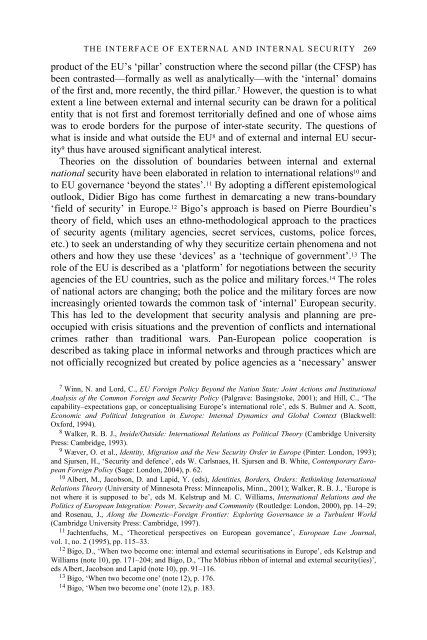The Nordic Countries and the European Security and Defence Policy
The Nordic Countries and the European Security and Defence Policy
The Nordic Countries and the European Security and Defence Policy
- No tags were found...
You also want an ePaper? Increase the reach of your titles
YUMPU automatically turns print PDFs into web optimized ePapers that Google loves.
THE INTERFACE OF EXTERNAL AND INTERNAL SECURITY 269product of <strong>the</strong> EU’s ‘pillar’ construction where <strong>the</strong> second pillar (<strong>the</strong> CFSP) hasbeen contrasted—formally as well as analytically—with <strong>the</strong> ‘internal’ domainsof <strong>the</strong> first <strong>and</strong>, more recently, <strong>the</strong> third pillar. 7 However, <strong>the</strong> question is to whatextent a line between external <strong>and</strong> internal security can be drawn for a politicalentity that is not first <strong>and</strong> foremost territorially defined <strong>and</strong> one of whose aimswas to erode borders for <strong>the</strong> purpose of inter-state security. <strong>The</strong> questions ofwhat is inside <strong>and</strong> what outside <strong>the</strong> EU 8 <strong>and</strong> of external <strong>and</strong> internal EU security9 thus have aroused significant analytical interest.<strong>The</strong>ories on <strong>the</strong> dissolution of boundaries between internal <strong>and</strong> externalnational security have been elaborated in relation to international relations 10 <strong>and</strong>to EU governance ‘beyond <strong>the</strong> states’. 11 By adopting a different epistemologicaloutlook, Didier Bigo has come fur<strong>the</strong>st in demarcating a new trans-boundary‘field of security’ in Europe. 12 Bigo’s approach is based on Pierre Bourdieu’s<strong>the</strong>ory of field, which uses an ethno-methodological approach to <strong>the</strong> practicesof security agents (military agencies, secret services, customs, police forces,etc.) to seek an underst<strong>and</strong>ing of why <strong>the</strong>y securitize certain phenomena <strong>and</strong> noto<strong>the</strong>rs <strong>and</strong> how <strong>the</strong>y use <strong>the</strong>se ‘devices’ as a ‘technique of government’. 13 <strong>The</strong>role of <strong>the</strong> EU is described as a ‘platform’ for negotiations between <strong>the</strong> securityagencies of <strong>the</strong> EU countries, such as <strong>the</strong> police <strong>and</strong> military forces. 14 <strong>The</strong> rolesof national actors are changing; both <strong>the</strong> police <strong>and</strong> <strong>the</strong> military forces are nowincreasingly oriented towards <strong>the</strong> common task of ‘internal’ <strong>European</strong> security.This has led to <strong>the</strong> development that security analysis <strong>and</strong> planning are preoccupiedwith crisis situations <strong>and</strong> <strong>the</strong> prevention of conflicts <strong>and</strong> internationalcrimes ra<strong>the</strong>r than traditional wars. Pan-<strong>European</strong> police cooperation isdescribed as taking place in informal networks <strong>and</strong> through practices which arenot officially recognized but created by police agencies as a ‘necessary’ answer7 Winn, N. <strong>and</strong> Lord, C., EU Foreign <strong>Policy</strong> Beyond <strong>the</strong> Nation State: Joint Actions <strong>and</strong> InstitutionalAnalysis of <strong>the</strong> Common Foreign <strong>and</strong> <strong>Security</strong> <strong>Policy</strong> (Palgrave: Basingstoke, 2001); <strong>and</strong> Hill, C., ‘<strong>The</strong>capability–expectations gap, or conceptualising Europe’s international role’, eds S. Bulmer <strong>and</strong> A. Scott,Economic <strong>and</strong> Political Integration in Europe: Internal Dynamics <strong>and</strong> Global Context (Blackwell:Oxford, 1994).8 Walker, R. B. J., Inside/Outside: International Relations as Political <strong>The</strong>ory (Cambridge UniversityPress: Cambridge, 1993).9 Wæver, O. et al., Identity, Migration <strong>and</strong> <strong>the</strong> New <strong>Security</strong> Order in Europe (Pinter: London, 1993);<strong>and</strong> Sjursen, H., ‘<strong>Security</strong> <strong>and</strong> defence’, eds W. Carlsnaes, H. Sjursen <strong>and</strong> B. White, Contemporary <strong>European</strong>Foreign <strong>Policy</strong> (Sage: London, 2004), p. 62.10 Albert, M., Jacobson, D. <strong>and</strong> Lapid, Y. (eds), Identities, Borders, Orders: Rethinking InternationalRelations <strong>The</strong>ory (University of Minnesota Press: Minneapolis, Minn., 2001); Walker, R. B. J., ‘Europe isnot where it is supposed to be’, eds M. Kelstrup <strong>and</strong> M. C. Williams, International Relations <strong>and</strong> <strong>the</strong>Politics of <strong>European</strong> Integration: Power, <strong>Security</strong> <strong>and</strong> Community (Routledge: London, 2000), pp. 14–29;<strong>and</strong> Rosenau, J., Along <strong>the</strong> Domestic–Foreign Frontier: Exploring Governance in a Turbulent World(Cambridge University Press: Cambridge, 1997).11 Jachtenfuchs, M., ‘<strong>The</strong>oretical perspectives on <strong>European</strong> governance’, <strong>European</strong> Law Journal,vol. 1, no. 2 (1995), pp. 115–33.12 Bigo, D., ‘When two become one: internal <strong>and</strong> external securitisations in Europe’, eds Kelstrup <strong>and</strong>Williams (note 10), pp. 171–204; <strong>and</strong> Bigo, D., ‘<strong>The</strong> Möbius ribbon of internal <strong>and</strong> external security(ies)’,eds Albert, Jacobson <strong>and</strong> Lapid (note 10), pp. 91–116.13 Bigo, ‘When two become one’ (note 12), p. 176.14 Bigo, ‘When two become one’ (note 12), p. 183.
















